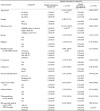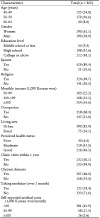Abstract
Background
It is important time for middle-aged because they should shift to a healthy elderly by utilization of correct health information and healthy behaviors. The aim of this study was to investigate the level of health information orientation (HIO) and identify the factors influencing HIO according to socio-demographic and health related characteristics of middle aged in community.
Methods
A cross-sectional descriptive study was conducted by self-reported using structured questionnaires. The data was collected from June to July 2014 with 465 middle aged and 40 to 64 years old living in the community. Multiple stepwise regression analysis was used to examine the determinant of HIO.
Results
In the two sub-domains of HIO, health information engagement mean score was 2.30±1.09 and the health information apprehension level was 1.34±1.15 on average (maximum 4 points). Regression analysis showed that the sub-domains of HIO, the level of health information engagement was significantly higher in the 40-49 age group than 50-64 age group (β=-0.094, P=0.048) and high school or above education level (β=0.224, P<0.001). Those who pay more than 100,000 won per month (β=0.097, P=0.047) were significantly high in the level of health information apprehension.
Conclusions
In order to improve the level of HIO, it is necessary to implement tailored health promotion education considering the sociodemographic and health related characteristics of the subjects. It is required in the future, the development of tools and multidimensional factors that are appropriate for the middle-aged when identifying the factors influencing of health information orientation.
Figures and Tables
Figure 1
Health information acquisition routea.
aValues are presented as frequency (%), available for multiple response.

Figure 2
Easily understandable health informationa.
aValues are presented as frequency (%), available for multiple response.

Table 3
Differences in health information engagement and health information apprehension according to socio-demographic and health related characteristics of participantsa

Table 4
Predictors of health information seeking and health information apprehensiona

Abbreviation: KRW, Korean won.
aCalculated by Multiple stepwise linear regression analysis adjusted for spouse, living area, occupation, chronic disease.
bAge; 50-64 yr=1, 40-49 yr=0.
cEducation level; high school or above=1, ≤Middle school or less=0.
dSelf-reported medical costs (1,000 KRW/month); ≥100=1, <100=0.
References
1. Shin NM, Choi J, Cho I, Park BJ. Self-management program for heart healthy behavior among middle- and old-aged Korean women at risk for metabolic syndrome. J Cardiovasc Nurs. 2017; 03. 17. [Epub ahead of print].

2. National Health Insurance Service. Prevalence of metabolic syndrome by age, sex and risk factors in Korea 2015 [Internet]. Daejeon: National Health Insurance Service;2017. Accessd Jan 31, 2017. Available from: http://kosis.kr/statHtml/statHtml.do?orgId=350&tblId=DT_35007_N139.
3. National Cancer Information Center. Cancer incidence by age group 2014 [Internet]. Goyang: National Cancer Information Center;2016. Accessd Dec 20, 2016. Available from: http://www.cancer.go.kr/mbs/cancer/subview.jsp?id=cancer_040103000000.
4. Jessup RL, Osborne RH, Beauchamp A, Bourne A. Health literacy of recently hospitalised patients: a cross-sectional survey using the Health Literacy Questionnaire(HLQ). BMC Health Serv Res. 2017; 17(1):52.

5. Bakker CJ, Koffel JB, Theis-Mahon NR. Measuring the health literacy of the Upper Midwest. J Med Libr Assoc. 2017; 105(1):34–43.

6. Chon BS, Lee JG. A study on dispositional use motives for facebook and its positive and negative effects: with a focus on changes to interpersonal networks on facebook and facebook addiction among users in the age groups of 2039 and 4059. Speech Commun. 2014; 24:112–140.
7. Dutta-Bergman MJ. Primary sources of health information: Comparisons in the domain of health attitudes, health cognitions, and health behaviors. Health Commun. 2004; 16(3):273–288.

8. Basu A, Dutta MJ. The relationship between health information seeking and community participation: the roles of health information orientation and efficacy. Health Commun. 2008; 23(1):70–79.

9. Howell JL, Shepperd JA. Reducing information avoidance through affirmation. Psychol Sci. 2012; 23(2):141–145.

10. McQueen A, Vernon SW, Swank PR. Construct definition and scale development for defensive information processing: an application to colorectal cancer screening. Health Psychol. 2013; 32(2):190–202.

11. DuBenske LL, Burke Beckjord E, Hawkins RP, Gustafson DH. Psychometric evaluation of the health information orientation scale: a brief measure for assessing health information engagement and apprehension. J health Psychol. 2009; 14(6):721–730.
12. Suziedelyte A. How does searching for health information on the Internet affect individuals' demand for health care services? Soc Sci Med. 2012; 75(10):1828–1835.

13. James DC, Harville C 2nd. eHealth literacy, online help-seeking hehavior, and willingness to participate in mHealth chronic disease research among African Americans, Florida, 2014-2015. Prev Chronic Dis. 2016; 13:E156.

14. Tan SS, Goonawardene N. Internet health information seeking and the patient-physician relationship: a systematic review. J Med Internet Res. 2017; 19(1):e9.

15. Son YJ, Song EK. Impact of health literacy on disease-related knowledge and adherence to self-care in patients with hypertension. J Korean Acad Fundam Nurs. 2012; 19(1):6–15.

16. Kim KJ, Lee IS. The influence of health information source credibility and e health literacy on health information orientation of parents of local hospitalized children. J Digit Converg. 2016; 14(6):295–307.

17. Park DJ, Kwon MS, Choi JH. The Influence of health information orientation, attitude of internet health information, and e-health literacy on personal health behaviors. J Public Relat Res. 2013; 17(3):379–413.
18. Feinberg I, Frijters J, Johnson-Lawrence V, Greenberg D, Nightingale E, Moodie C. Examining associations between health information seeking behavior and adult education status in the U.S.: an analysis of the 2012 PIAAC Data. PloS One. 2016; 11(2):e0148751.

19. Ojewola RW, Oridota ES, Balogun OS, Ogundare EO, Alabi TO. Lower urinary tract symptoms: prevalence, perceptions, and healthcare-seeking behavior amongst Nigerian men. World J Mens Health. 2016; 34(3):200–208.

20. Nölke L, Mensing M, Krämer A, Hornberg C. Sociodemographic and health-(care)related characteristics of online health information seekers: a cross-sectional German study. BMC Public Health. 2015; 15:31.

21. Miller SM. Monitoring and blunting: validation of a questionnaire to assess styles of information seeking under threat. J Pers Soc Psychol. 1987; 52(2):345–353.

22. Loiselle CG. Self-evaluation and health information-seeking: a study of self-assessment and self-protection motives [dissertation]. Madison: University of Wisconsin;1995. English.
23. McQueen A, Vernon SW, Swank PR. Construct definition and scale development for defensive information processing: an application to colorectal cancer screening. Health Psychol. 2013; 32(2):190–202.

24. Moon IO, Park SK, Kim EG. Influence on health promotion behavior among nursing students according to health information seeking behavior. J Korean Public Health Nurs. 2015; 29(2):231–243.

25. Fiksdal AS, Kumbamu A, Jadhav AS, Cocos C, Nelsen LA, Pathak J, et al. Evaluating the process of online health information searching: a qualitative approach to exploring consumer perspectives. J Med Internet Res. 2014; 16(10):e224.

26. Knapp C, Madden V, Wang H, Sloyer P, Shenkman E. Internet use and eHealth literacy of low-income parents whose children have special health care needs. J Med Internet Res. 2011; 13(3):e75.

27. Berkman ND, Davis TC, McCormack L. Health literacy: what is it? J Health Commun. 2010; 15:Suppl 2. 9–19.

28. Lalazaryan A, Zare-Farashbandi , F . A review of models and theories of health information seeking behavior. Int J Health Syst Disaster Manage. 2014; 2(4):193–203.





 PDF
PDF ePub
ePub Citation
Citation Print
Print




 XML Download
XML Download